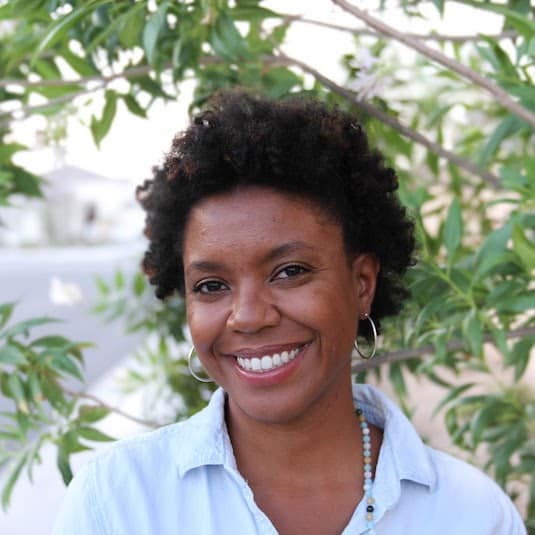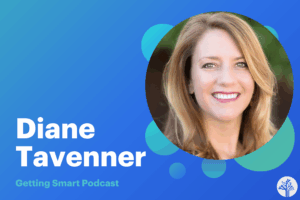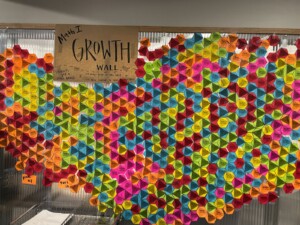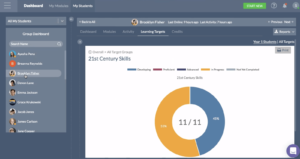Competency-Based Education: Definitions and Difference Makers

By Janice Walton and Mary Ryerse (Updated December 2021)
Across the country, there is a growing movement to transition away from seat-time and move towards a flexible structure that allows students to progress in their learning after they have demonstrated mastery, which is oftentimes at their own pace. This movement, which extends well beyond issues of time and pace, is known as competency-based education (CBE). Numerous organizations, states, districts and schools have taken the steps to begin implementing CBE within their own contexts.
In this blog, we aim to capture a sampling of CBE definitions and difference makers. It is important to note that — as with any impactful, complex and relatively new approach — there are a variety of perspectives on the topic. We share this information with a humble recognition that, as a field, we are early in the shift from time-based to learning-based as the key milestones in education, or where “learning is constant, and time is the variable.” Early models within competency-based education fall along a continuum from constructivist educators that advocate project-based learning and teacher judgements to those seeking more consistent and scalable approaches. The section that follows introduces leading definitions of competency-based education and related concepts with an effort to hold in tension the benefits of authenticity and agency as well as merits of consistency, comparability, and portability.
We believe that, through continued progress, the goals of those who advocate for a constructivist, project-based approach and those who want to ensure scalability, portability, rigor and consistency can be merged.
Defining Competency-Based Education
Arguably, most widely used definition has been established by iNACOL, an international non-profit dedicated to catalyzing “the transformation of K-12 education policy and practice to advance powerful, personalized, learner-centered experiences through competency-based, blended and online learning” and CompetencyWorks, a project of iNACOL dedicated to providing information and knowledge about K-12 competency education.
Both organizations, together with 100 leaders in competency education, came together in 2011 to develop a working definition of competency-based education which encompasses five elements:
Each of these elements is further articulated in the report excerpt What is Competency Education?, and summarized below:
- Students advance upon demonstrated mastery. Moving towards mastery allows students to potentially spend more time working in those areas that are more difficult for them. They may even advance beyond grade level in some domains, while taking more time in those that are more challenging. Mastery also allows the teacher to focus assistance on where students need the most help while also ensuring they learn what is needed to advance to the next level of learning.
- Competencies include explicit, measurable, transferable learning objectives that empower students. With greater transparency in learning objectives, students have greater ownership over their education and increased opportunity for choice in how they learn and how they demonstrate their learning. In this process, teachers also collaborate more with students as they increase their intentionality on what they want students to know and be able to do.
- Assessment is meaningful and a positive learning experience for students. Formative assessments are emphasized so teachers better understand where students have misconceptions, and students receive the feedback they need to improve.
- Students receive timely and differentiated support based on their individual learning needs. Flex time during the day is provided for students to receive additional instructional support and ensure misconceptions are addressed quickly. For example, when students don’t complete a course, they focus on the specific skills they need to develop rather than retake the entire course.
- Students develop and apply a broad set of skills and dispositions. Students actively learn and apply critical-thinking and problem-solving skills along with the “critical skills of communication, collaboration and cultural responsiveness to help them work in ever-changing, diverse workplaces.”
Additional CBE Definitions
In addition to iNACOL and CompetencyWorks, there are many, many organizations that are contributing to the field of competency-based education. Some offer a slightly different take on defining this concept but all are working to ensure students have a flexible learning environment where they can master content.
It is important to note that there are many terms used synonymously with CBE:
- Competency education: CompetencyWorks uses both CBE and competency education
- Proficiency-based learning: Great Schools Partnership and across New England
- Mastery-based learning: popularized by Benjamin Bloom, now used in New York City
- Performance-based learning: Chugach School District, Lindsay USD, Mesa County District 51
Leading Organizations on CBE
Below, we have outlined information about several leading organizations and their take on related terminology:
Great Schools Partnership
Great Schools Partnership (GSP). GSP is a nonprofit “school-support organization working to redesign public education and improve learning for all students.” The mission of GSP is to “develop and advocate for sustainable educational policies, effective school leadership, proven instructional practices, and student-centered learning models built on strong community connections.” The organization, led by Executive Director David Ruff, coordinates for the New England Secondary School Consortium and the League of Innovative Schools.
GSP uses the term proficiency-based learning, and defines it as, “systems of instruction, assessment, grading, and academic reporting that are based on students demonstrating that they have learned the knowledge and skills they are expected to learn as they progress through their education.” To expand upon this definition, GSP has developed ten principles of proficiency-based learning, many of which are also in alignment with the elements noted by iNACOL, CompetencyWorks and JFF.
Jobs for the Future
Jobs for the Future (JFF) is a national nonprofit with a mission to “ensure that all lower-income young people and workers have the skills and credentials needed to succeed in our economy.” JFF refers to its competency-based initiative as Students at the Center and has developed a hub which serves as a resource for educators, families, students and communities wanting to learn more about research, best practices, supportive policies, and how to talk about student-centered approaches to learning. Associate VP Rebecca Wolfe leads related efforts.
In the paper, The Past and the Promise: Today’s Competency Education Movement, JFF identifies that there are three main elements at the core of competency education:
- Mastery: “Students advance to the next level, course, or grade based on demonstration of skills and content knowledge.”
- Pacing: “Students progress at different rates in different areas, rather than on a teacher-driven, class-wide schedule.”
- Instruction: “Students receive customized supports to match their individual learning needs to keep them learning increasingly challenging material in a developmentally appropriate and motivating manner.”
KnowledgeWorks
KnowledgeWorks is a national organization “committed to providing every learner with meaningful personalized learning experiences that ensure success in college, career and civic life.” It is their mission to “deliver innovative education approaches and advance aligned policies, by activating and developing the capacity of communities and educators to imagine, build and sustain vibrant learning ecosystems that allow each student to thrive.”
KnowledgeWorks describes competency-based education as, “education [that]empowers students through clear learning targets that they work toward at their own pace. Competency-based education, sometimes called proficiency- or mastery-based learning, creates a culture where teachers, learners and community members set a shared vision and build innovative and transparent learning environments where all students grow.” It is noteworthy that in addition to listing the elements for how students are engaged, KnowledgeWorks also lists how educators are empowered and how the community can thrive.
| Educators are empowered by: | The community can thrive by: |
| Developing a comprehensive set of learning outcomes and meaningful ways to assess student progress and growth | Partnering with educators, administrators and other stakeholders to co-create a vision for teaching and learning |
| Effectively supporting individual student needs | Forging partnerships with the school district to create learning opportunities |
| Having the autonomy, structure and support they need to develop creative ways to meet students where they are | Working with K-12 stakeholders to prepare students with skills needed for local jobs |
| Building a shared understanding between students, parents and teachers | Building a pipeline of skilled future employees to help support a thriving economy |
| Collaborating with fellow teachers to create interdisciplinary learning opportunities |
EDUCAUSE
EDUCAUSE is a “higher education technology association and the largest community of IT leaders and professionals committed to advancing higher education.” Andy Calkins is the Director of Next Generation Learning Challenges (NGLC) which is a part of EDUCAUSE’s Teaching and Learning focus initiative and is a collaborative among philanthropic foundations, educators, innovators and technologists. NGLC is focused on addressing the barriers to educational innovation by tapping the potential of technology to improve college readiness and completion, particularly for low-income young adults. Competency-based education is defined as an “approach [that] allows students to advance based on their ability to master a skill or competency at their own pace regardless of environment. This method is tailored to meet different learning abilities and can lead to more efficient student outcomes.”
What all of these definitions have in common is the theme of mastery, pacing and individualized instruction. The organizations above represent some of the primary thought leaders involved in this space, to learn how other organizations define competency-based education see:
More Difference Makers and Resources
We recognize that by calling out a handful of organizations and resources, we run the risk of leaving out individuals and organizations who are contributing to a body of knowledge and practice (and we plan to share more on exemplar states, districts and schools shortly). We consider these people to be difference makers and strongly believe in their work and mission. What follows is a slightly expanded list of related organizations and resources:
- Digital Promise & Education Elements Competency-Based Education Toolkit
- Foundation for Excellence in Education, Competency-Based Education: Fundamental Principles
- Getting Smart, iNACOl, Competency Works, The Shift from Cohorts to Competency
- Lumina Foundation, The Degree Qualifications Profile
- Mastery Collaborative, What is Mastery?
- Marzano Research, Personalized Competency-Based Education
- United States Department of Education, Competency-Based Learning or Personalized Learning
- RAND/Gate Foundation, Interim Research on Personalized Learning
- reDesign, Competency-Based Education
Lastly, it is important to note that a definition is concrete and can be written down. However, in order for it to be powerful enough to be transformative, it has to be held in a culture and ought to evolve through collective learning and research. There are learning communities across the country grappling with these ideas. We are likely to revise as we go.
We are optimistic advocates for personalized and blended learning. We believe that, along the spectrum briefly referenced above, there is something to learn from everyone. We believe that, through continued progress, the goals of those who advocate for a constructivist, project-based approach and those who want to ensure scalability, portability, rigor and consistency can be merged.
What other organizations do you know of that working on competency-based education? We recognize we may have missed some, so please leave the organization name in the comments below.
For more, see:
- Conversations on Competency
- The Shift from Cohorts to Competency
- Competency-Based Education Toolkit
- What is Mastery?
This post includes mentions of a Getting Smart partner. For a full list of partners, affiliate organizations and all other disclosures, please see our Partner page.








ANITE AMINA
It's a good curriculum if only those at the villages also benefit just like their counter parts in Urban area's otherwise it won't be equity and accessibility to all. Thanks
ANITE AMINA
It's a good curriculum if only those in rural areas also benefit otherwise it won't serve it's purpose of equity and accessibility for all
Albert Ellis
It is good if and when students can see the importance and value of their own learning and look past getting a grade.